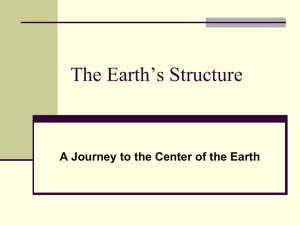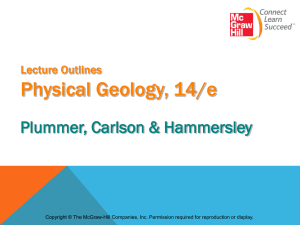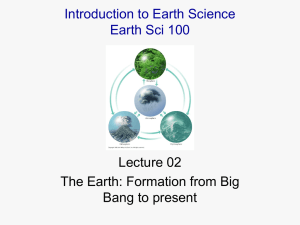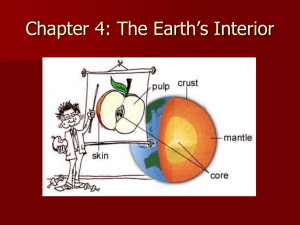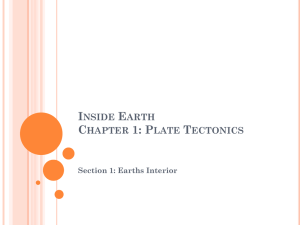Earth`s Magnetic Field
advertisement
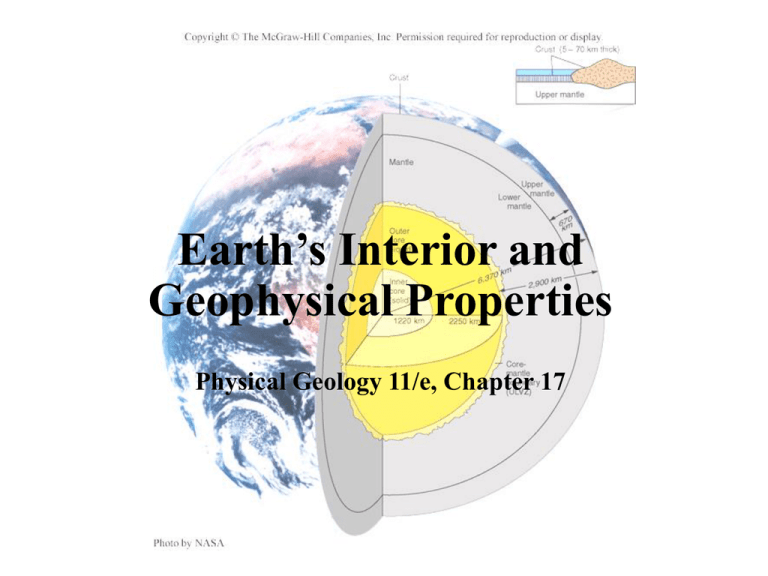
Earth’s Interior and Geophysical Properties Physical Geology 11/e, Chapter 17 Introduction • Geophysics is the branch of geology that studies the interior of the Earth • Deep interior of the Earth must be studied indirectly – Deepest drillhole was about 12 km, but did not reach the mantle Introduction • Direct access only to crustal rocks and small upper mantle fragments brought up by volcanic eruptions or accreted onto continents by subducting oceanic plates Evidence from Seismic Waves • Seismic waves or vibrations from a large earthquake (or underground nuclear test) will pass through the entire Earth – Affected by the properties of Earth materials, • Density and state (solid or liquid) may result in changes in seismic wave velocity, reflection, refraction, or both reflection and refraction. • Allow geologists to ‘see’ into the Earth Evidence from Seismic Waves • Seismic reflection - the return of some waves to the surface after bouncing off a rock layer boundary – Sharp boundary between two materials of different densities will reflect waves Evidence from Seismic Waves • Seismic refraction - bending of seismic waves as they pass from one material to another with different seismic velocities – V2 > V1 = ‘upward’ refraction – V2 < V1 = ‘downward’ refraction • Seismic velocity (and density) of the mantle increases uniformly with depth – Curved ray paths result because the wavefronts are continuously refracted Earth’s Internal Structure • The crust, mantle and core, the three main layers within the Earth, have been determined based on seismic evidence. The Crust • The crust is the outer layer of rock that forms a thin skin on Earth’s surface • Seismic wave studies indicate that the crust is thinner and denser beneath the oceans than on the continents The Crust • Seismic wave velocities are different in oceanic (7 km/sec) vs. continental (~6 km/sec) crustal rocks – Indicate different compositions • Oceanic crust is mafic – Primarily of basalt and gabbro (basaltic and gabbroic) • Continental crust is felsic – Average composition is similar to granite and rhyolite (granitic and rhyolitic) Crust-Mantle Boundary • The crust-mantle boundary, called the Mohorovičić discontinuity or Moho, is marked by a jump in seismic wave velocity. The Mantle • The mantle is a thick shell of dense rock that separates the crust above from the core below • Seismic wave studies indicate the mantle, like the crust, is made of solid rock with only isolated pockets of magma • Higher seismic wave velocity (8 km/sec) of mantle vs. crustal rocks indicate denser, ultramafic composition The Mantle • Crust + upper mantle = lithosphere, the brittle outer shell of the Earth that makes up the tectonic plates • Lithosphere averages 70 km thick beneath oceans and 125-250 km thick beneath continents • Beneath the lithosphere, seismic wave speeds abruptly decrease in a plastic lowvelocity zone called the asthenosphere The Mantle The Core-Mantle Boundary • Core-mantle boundary (D” layer) is marked by great changes in seismic velocity, density and temperature – P-wave velocitites dramatically decrease • Ultralow-velocity zone (ULVZ) – Due to hot core melting lowermost mantle or reacting chemically to form iron silicate ‘sediments’ The Core • The core is the metallic central zone of the Earth – Subdivided into a liquid outer core and solid inner core • Seismic wave studies have provided primary evidence for existence and nature of Earth’s core The Outer Core • Seismic shadow zones – Specific areas on the opposite side of the Earth from large earthquakes do not receive seismic waves – S-wave shadow zone (≥103° from epicenter) suggests outer core is liquid • Liquids have no shear strength – P-wave shadow zone (103°-142° from epicenter) explained by refraction of waves encountering core-mantle boundary • Decreased velocity causes wavefront to be refracted ‘downward’ The Inner Core • Careful observations of P-wave refraction patterns indicate that inner core is solid • Core composition inferred from its calculated density, physical and electro-magnetic properties, and composition of meteorites – Iron metal (liquid in outer core and solid in inner core) best fits observed properties – Iron is the only metal common in meteorites Other Geophysical Properties of the Earth • Isostasy - equilibrium of adjacent blocks of brittle crust “floating” on upper mantle – Thicker blocks of lower density crust have deeper “roots” and float higher (as mountains) Isostasy • Isostatic adjustment - rising or sinking of crustal blocks to achieve isostatic balance – Crust will rise when large mass is rapidly removed from the surface, as at end of ice ages – Rise of crust after ice sheet removal is called crustal rebound • Rebound still occurring in northern Canada and northern Europe Gravity Measurements • Gravitational force between two objects determined by their masses and the distance between them Gravity Measurements • Gravity meters - detect tiny changes (anomalies) in gravity at Earth’s surface related to total mass beneath any given point – Gravity slightly higher (positive gravity anomaly) over dense materials (metallic ore bodies, mafic rocks) – Gravity slightly lower (negative gravity anomaly) over less dense materials (caves, water, magma, sediments, felsic rocks) Earth’s Magnetic Field • A magnetic field (region of magnetic force) surrounds the Earth – Field has north and south magnetic poles – A compass detects Earth’s magnetic field – Recorded by magnetic minerals (e.g., magnetite) in igneous rocks as they cool Earth’s Magnetic Field • Magnetic reversals - times when the poles of Earth’s magnetic field switch – After next reversal, a compass needle will point toward the south magnetic pole – Direction recorded in magnetic minerals – Minerals also recorded the time that they formed • Radioactive decay • Reversals have occurred many times • Timing appears chaotic, no discernable pattern Earth’s Magnetic Field • Paleomagnetism - the study of ancient magnetic fields in rocks – Allows reconstruction of plate motions over time Magnetic Field Strength • Magnetometers are used to measure local magnetic field strength – Used as metal detectors in airports • Measurements of local increases or decreases in the Earth’s magnetic field strength are known as magnetic anomalies Magnetic Anomalies • Positive and negative magnetic anomalies represent larger and smaller than average local magnetic field strengths, respectively • Can detect metallic ore deposits, igneous rocks (positive anomalies), and thick layers of non-magnetic sediments (negative anomaly) beneath Earth’s surface Heat Flow Within Earth • Geothermal gradient - temperature increase with depth – Tapers off sharply beneath lithosphere – Due to steady pressure increase with depth, increased temperatures produce little melt (mostly within asthenosphere) except in the outer core Heat Within the Earth • Heat is gradually lost through Earth’s surface – Major heat sources include radioactive decay and original heat (from accretion and compression as Earth formed) – Locally higher where magma is near surface – Heat loss is of the same magnitude in ocean and continental crust • Different heat sources – Oceanic crust from mantle – Continental crust from radioactive decay within the crust) End of Chapter 17…


